Creating Safe Spaces: Designing Classrooms for Security and Safety

In recent years, classrooms worldwide have experienced an unprecedented shift. Now more than ever, children require an environment that cultivates a sense of safety; they need an environment that’s not just conducive to learning but also their sense of well-being. A school is a place where students thrive upon engagement and connectedness. Our internal processes intertwine with our external surroundings, and if a student’s environment doesn’t promote safety and support, the student will feel the effects. Statistics point toward a worrying trend.
Fostering Safety Through Design

Our Relationship With Our Surroundings: Word on the Ground
Upon entering a space, we’re instantly barraged – consciously and subconsciously – by stimuli. Our minds naturally scan the environment and note whether it’s comforting or uninviting, warm or cold, safe or unsafe. This is particularly true with children. Research supports this, noting that children raised in adverse environments often have hindered brain development, increasing their risk of memory issues, learning difficulties, and behavioural problems [3].
Our environment can also raise or lower stress levels, impacting mental health or even inducing conditions that lead to mental illness [4]. Essentially, the environment we inhabit has the potential to safeguard our mental well-being or act as a catalyst for mental health issues. Dr Adam England of Noble & Eaton found this to be true. In speaking with a school, he discovered that a group of girls in Year 7 commented on the importance of design. Namely, how the design of a school made them feel safe. Such an anecdote indicates that this topic is essential in raising awareness for child safety.
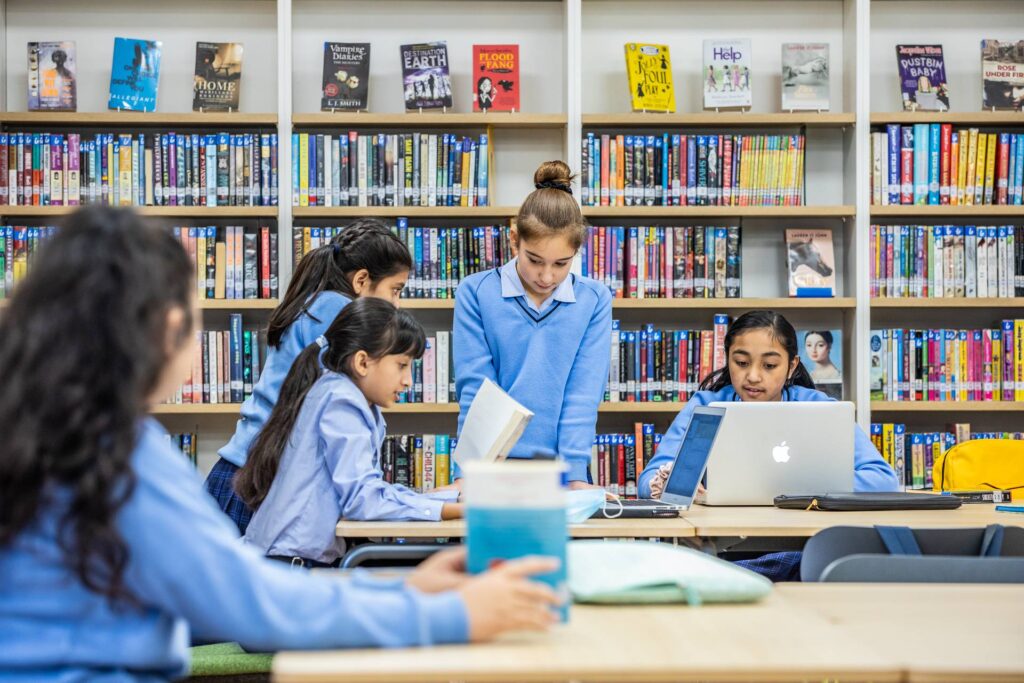
The Neuroscience of Feeling Safe and Connected
To understand how to create an environment that fosters feelings of safety, we must first explore the impact physical surroundings have on our minds. A study published in the journal Neurobiology of Learning and Memory, for one, suggested that the amygdala is the part of the brain involved in mediating emotional arousal [5].
This has a strong impact on learning. The amygdala is responsible for processing emotions, memory, and specific aspects of behaviour. A stressful environment can exacerbate the amygdala, physically preventing information from reaching the brain centres necessary for absorbing new knowledge [6].
Therefore, it makes sense to cultivate the learning atmosphere as much as the learning itself. Mariale Hardiman, a former administrator and current assistant dean of the Urban Schools Partnership at Johns Hopkins University’s School of Education, supports this, claiming that
‘Reducing stress and establishing a positive emotional climate in the classroom is arguably the most essential component of teaching’ [7].
As humans, we’re wired to respond to potential threats in our surroundings. We may fight, retreat, or, in more extreme cases, freeze up entirely. If our environment is unwelcoming or alien, our emotional and physical responses will align with it. So, from an evolutionary perspective, it’s natural that familiarity leads to comfort. But what can bring on such feelings of familiarity?

Biophilia and a Sense of Safety
Humans have an inherent need to connect with nature. To help us feel safe, our brains seek things we recognise and feel familiar with. In any environment, plants and nature are highly familiar, so the presence of biophilia in a classroom can help foster that sense of safety in young people. In fact, award-winning architect Amanda Sturgeon notes this in her eye-opening presentation of biophilic design. She explains that when asked to draw a picture of their favourite spaces, 96% of children will draw something in nature. In line with this, test scores increased by 25% in classrooms with windows letting in natural light [8].
Edward O. Wilson, renowned Harvard biologist and conservationist, reinforces this viewpoint, stating that ‘humanity is not an entity and a force that’s risen above nature. We’re part of nature’ [9]. Wilson’s theory supports the idea that our brains have been moulded to think like hunter-gatherers for thousands of years [10]. In basic terms, humans have a deep bond with nature due to its familiarity and ability to provide us with everything we need for survival.
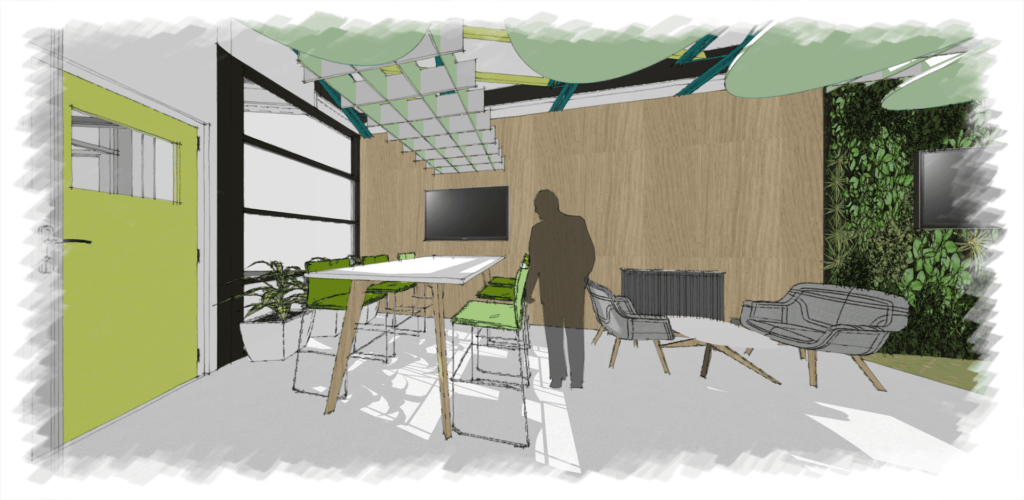
The Impact of Biophilic Design
Through such anecdotal and empirical evidence, the importance of biophilia in the classroom is clear. A landmark 2019 study found that children in Denmark exposed to more greenery had 55% fewer mental health problems later in life than those who weren’t exposed to nature [11].
And from a design perspective, the presence of nature is effortlessly fascinating. It captures our attention without requiring us to consciously focus on it. Gazing at natural environments allows us to replenish our stores of attention control, simultaneously conserving our internal resources and increasing productivity [12]. Further, adding elements of nature to inside spaces can positively impact cognition and emotion, reducing stress and improving overall well-being [13].

- How to Add Biophilic Design to Classrooms
With the advantages of biophilic design laid out, what are some examples of practical implementation in the classroom? Let’s delve into some possible inclusions:
Moss Walls
Moss walls are an innovative and visually appealing biophilic design that can bring nature inside. These vertical installations consist of preserved mosses that require no watering or maintenance. The presence of moss walls can offer various benefits, including:
- Noise reduction: Moss walls have excellent sound-absorbing properties, helping to minimise background noise and creating a calmer learning atmosphere. This is particularly important when considering appropriate acoustical design [14].
- Stress reduction: As previously mentioned, the presence of natural elements, such as moss, has been shown to reduce stress levels and enhance overall well-being.
- Improved air quality: Moss can filter and purify the air by absorbing pollutants and releasing oxygen, creating a healthier environment for students, both physically and mentally.
Biophilic Walls
In a similar vein, biophilic walls (also known as green walls or living walls) are vertical gardens that can transform the aesthetic appeal of classrooms while bringing the benefits of nature indoors. You can create these walls by installing various plants, such as ferns, ivy, or other low-maintenance species. Incorporating biophilic walls can help by offering:
- Visual appeal and creativity: Green walls provide a visually stimulating environment, enhancing creativity and engagement among students.
- Improved air quality: Like moss walls, biophilic walls contribute to air purification, reducing toxins and increasing oxygen levels in the classroom.
- Enhanced focus and productivity: Exposure to greenery has been linked to improved concentration, focus, and academic performance, creating a conducive learning environment [15].
Potted Plants
One of the simplest and most cost-effective ways to introduce biophilic design into classrooms is by placing potted plants strategically throughout the space. Some benefits include:
- Improved well-being: Again, plants have a calming effect on individuals, promoting relaxation and reducing stress. This can positively impact students’ emotional well-being and create a more productive learning environment.
- Increased humidity and reduced dust: Plants release moisture through a process called transpiration, increasing humidity levels in the classroom. This can help prevent dryness and reduce the accumulation of dust particles.
- Biophilic learning opportunities: Potted plants also provide excellent teaching tools for biology and environmental science lessons. Students can observe plant growth, learn about photosynthesis, and develop a sense of responsibility through plant care activities. Dynamic teaching such as this can improve student engagement, an important aspect of a positive learning environment [16].
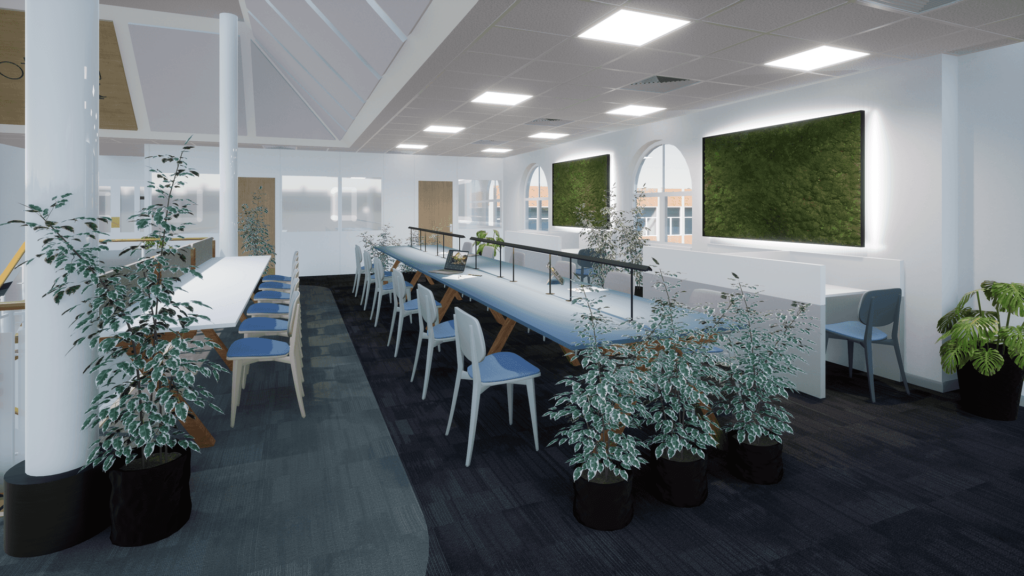
The Impact of Clutter
Mess means stress. Research suggests that the state of our physical environment can affect our productivity, triggering coping and avoidance strategies [17]. Essentially, disorganisation and clutter have a cumulative impact on our brains. The visual distraction of clutter increases cognitive overload and can reduce our working memory. As such, when a learning environment is untidy and without order, students will experience the effects. Clutter can cause us to feel stressed, anxious, and depressed. For example, a recent study found levels of the stress hormone cortisol to be higher in mothers in cluttered home environments [18].
Additionally, in 2011, neuroscience researchers using fMRI (functional magnetic resonance imaging) and other physiological measurements found clearing clutter resulted in improved focus and increased productivity [19]. If a student feels unproductive in their learning environment, they’re more likely to experience spiked cortisol levels and feelings of inadequacy [20]. Emotions play a crucial role in how and why students learn. The design of their surroundings should represent this.
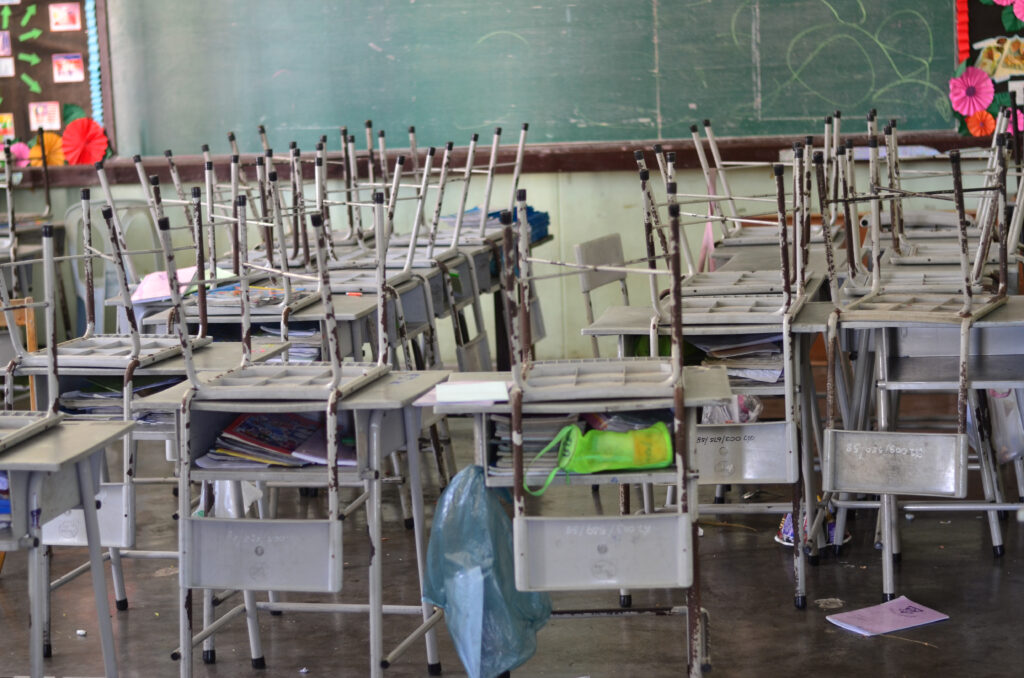
Design Elements for Storage
With this in mind, educators should be aware of possible tools that could help declutter their environments. The Envoplan teaching wall, for example, helps students focus their attention while creating a space-efficient storage solution. As part of an innovative range that can fit into virtually any space, you can solve classroom storage issues and manage clutter.
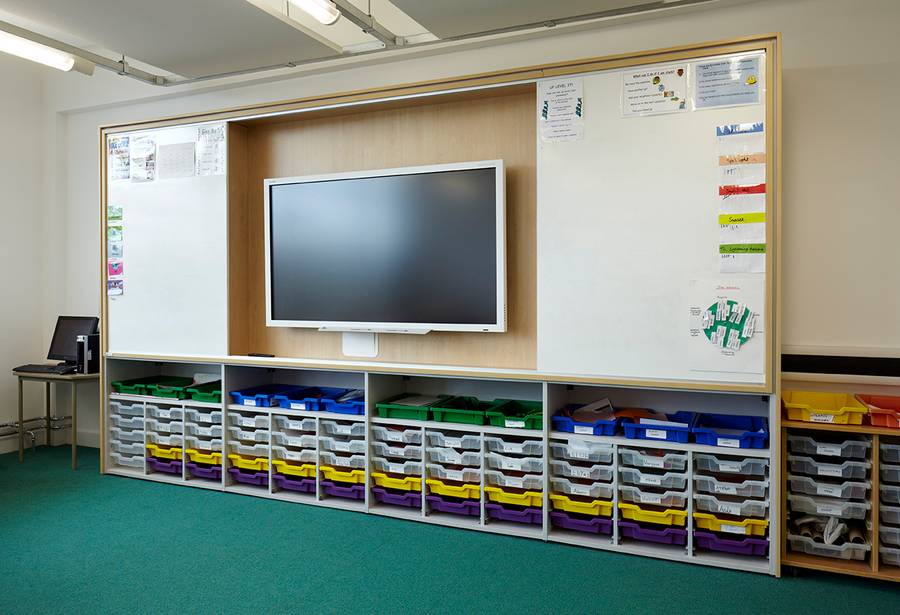
Acoustical Design
Acoustics play a vital role in shaping the atmosphere of any educational setting. Whether it’s the bustling hallways, crowded assembly halls, or quiet classrooms, acoustics are ever-present. And poor acoustical design doesn’t simply boil down to loud noise. It can impact the learning process, make it harder to follow instructions and affect students’ behaviour [21]. Therefore, it becomes imperative that every school takes proactive measures to enhance acoustics where possible. But what are the underlying causes of poor acoustics?
Echoing and Reverberation
A prevalent indicator of poor acoustics is the presence of echoing or reverberation. Echoes often arise from hard surfaces that reflect sound waves, creating a distorted listening experience. This hinders effective collaboration and fosters a sense of disconnection among students [22]. Identifying potential culprits such as bare floors, uncovered walls, wooden or metal furniture, and unadorned windows is vital in addressing this issue.
The Absence of Sound-absorbing Materials
Another common challenge stems from the absence of sound-diffusing or sound-absorbing materials within a room. Acoustical problems intensify when sound waves are left unregulated. Incorporating soft materials like cushioned furniture, fabric curtains, and foam panels can significantly reduce sound reflection and echo. Even hanging paintings on the walls can contribute to mitigating these acoustic disturbances. Introducing objects that can absorb sound upon impact is the most effective strategy to prevent sound waves from bouncing around the room[23].
How Acoustical Design Can Foster Feelings of Safety
A well-designed acoustic environment contributes to students’ safety in a surprisingly significant way. By effectively managing sound within the space, good acoustical design reduces distractions and promotes clear communication, allowing students to feel more focused and secure in their learning environment. As we’ve touched upon, excessive noise levels, such as reverberation and external disturbances, can create anxiety and stress among students.
Conversely, a properly designed classroom with appropriate sound-absorbing materials and strategically placed acoustic elements helps control unwanted noise and enhance speech intelligibility. This enables students to better understand and engage with their teachers and peers, fostering a sense of connection and trust. When students can hear and be heard clearly, they feel a greater sense of belonging, which promotes their overall psychological well-being and, altogether, contributes to a safer and more inclusive school environment [24].

Thoughtful Classroom Design Matters
Ultimately, fostering students’ emotional regulation and academic success hinges on establishing an atmosphere that prioritises safety. The layout of any learning space plays a crucial role in promoting this sense of safety. From biophilic design to reducing clutter, improving acoustics to inducing familiarity with a touch of innovation, students will feel the impact. By prioritising safety and well-being through thoughtful design, we can cultivate classrooms where students thrive, learn, and feel secure.
References
[1] Mori, Y. et al. (2022b) “Feeling Unsafe at School Among Adolescents in 13 Asian and European Countries: Occurrence and Associated Factors,” Frontiers in Psychiatry, 13.
[2] Taylor, C. Aesthetics and Well-Being: How Interior Design Affects Your Happiness – PsychologyTomorrowMagazine.
[3] Bick, J. and Nelson, C.A. (2015) “Early Adverse Experiences and the Developing Brain,” Neuropsychopharmacology, 41(1), pp. 177–196.
[4] Helbich, M. (2018) “Mental Health and Environmental Exposures: An Editorial,” International Journal of Environmental Research and Public Health, 15(10), p. 2207.
[5] Tyng, C.M. et al. (2017) “The Influences of Emotion on Learning and Memory,” Frontiers in Psychology, 8.
[6,7] Bernard, S. (2010) “To Enable Learning, Put (Emotional) Safety First,” Edutopia [Preprint].
[8] Sturgeon, A. (2021) Rediscovering biophilic design – Amanda Sturgeon.
[9] Mooney, C. (2015) “E.O. Wilson explains why parks and nature are really good for your brain,” Washington Post, 30 September.
[10] “Our Hunter-Gatherer Heritage and the Evolution of Human Nature” (2021) in Cambridge University Press eBooks, pp. 41–63.
[11] Engemann, K. et al. (2019) “Residential green space in childhood is associated with lower risk of psychiatric disorders from adolescence into adulthood,” Proceedings of the National Academy of Sciences, 116(11), pp. 5188–5193.
[12] Torres, N. (2017) Gazing at Nature Makes You More Productive: An Interview with Kate Lee.
[13] Grinde, B. and Patil, G.G. (2009b) “Biophilia: Does Visual Contact with Nature Impact on Health and Well-Being?,” International Journal of Environmental Research and Public Health, 6(9), pp. 2332–2343.
[14] Christensson, J. “Good acoustics for teaching and learning.”
[15] Ryan Hannah. “The Effect of Classroom Environment on Student Learning”
[16] The Dynamic Teaching Model.
[17] Vartanian, L.R., Kernan, K.M. and Wansink, B. (2016b) “Clutter, Chaos, and Overconsumption: The Role of Mind-Set in Stressful and Chaotic Food Environments,” Social Science Research Network [Preprint].
[18] Saxbe, D.E. and Repetti, R.L. (2009) “No Place Like Home: Home Tours Correlate With Daily Patterns of Mood and Cortisol,” Personality and Social Psychology Bulletin, 36(1), pp. 71–81.
[19] McMains, S.A. and Kastner, S. (2011) “Interactions of Top-Down and Bottom-Up Mechanisms in Human Visual Cortex,” The Journal of Neuroscience, 31(2), pp. 587–597.
[20] THE Campus Learn, Share, Connect (2023) “Emotions and learning: what role do emotions play in how and why students learn?,” 25 May.
[21] L. C. Sutherland a and D. The Impact of Classroom Acoustics on Scholastic Achievement Lubman
[22] Astolfi, A. et al. (2019) “Influence of Classroom Acoustics on Noise Disturbance and Well-Being for First Graders,” Frontiers in Psychology, 10.
[23] Spiers, O. (2023) “GB Acoustics – The importance of acoustic treatment in school classrooms,” GB Acoustics [Preprint].
[24] Sarlati, S. et al. (2014) “The Importance of Acoustic Quality in Classroom,” Jurnal Teknologi, 70(7).


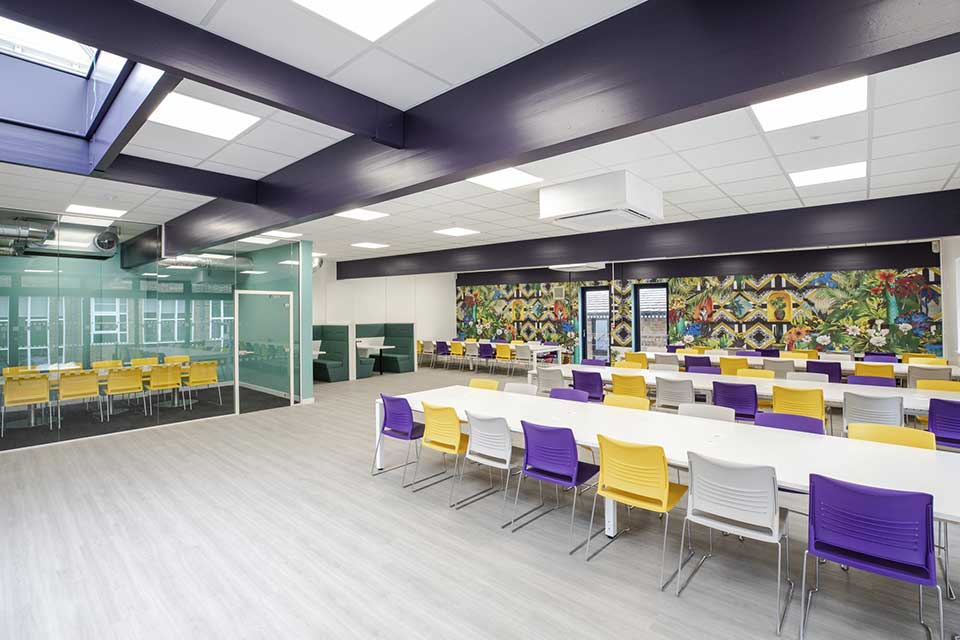

Leave a Reply